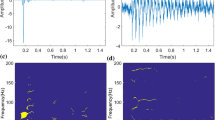Abstract
In recent years, distributed fiber acoustic sensor (DAS) technology has been applied for high-precision acquisition of vertical seismic profile (VSP) data, which has the advantages of high-density acquisition, low cost, safety and coordination. However, coupling noise with characteristics similar to that of the spring is produced and mixed in the VSP data collected by the distributed optical fiber in the well. The energy of the coupling noise tends to be very strong, resulting in the effective VSP data being covered. In this paper, coupling noise is constructed by analyzing its morphological characteristics. The dictionaries of coupling noise and clean VSP data are constructed respectively using their different characteristics, and the morphological component analysis (MCA) algorithm is proposed to separate them. The alternating direction multiplier method (ADMM) is used to solve the objective function, for which both L1 and L2 norm regularizations are adopted in the MCA algorithm. However, the performance of the algorithm heavily relies on the coefficient selection of the threshold, which can lead to noise residue in the denoised VSP data and effective signal attenuation due to the inappropriate selection of the threshold. Therefore, the frequency-wavenumber (FK) transform is further used to extract VSP data from the separated coupling noise. The proposed MCA and FK transform (MCA–FK) algorithm is applied to the field data and has achieved good results.










Similar content being viewed by others
References
Aghamiry HS, Gholami A, Operto S (2020) Multiparameter wavefield reconstruction inversion for wave speed and attenuation with bound constraints and total variation regularization. Geophysics 85(4):R381–R396
Chen J, Chen W, Wang X, Zhou Y, Zhang G (2018) DAS coupling noise suppression using wavelet and DCT dictionary based on sparse optimization. SEG Technical Program Expanded Abstracts 2018
Chen J, Ning J, Chen W, Wang X, Zhang G (2018b) Distributed acoustic sensing coupling noise removal based on sparse optimization. Interpretation 7(2):1–58
Daley TM, Freifeld BM, Ajo-Franklin J, Dou S, Pevzner R, Shulakova V, Miller DE, Goetz J, Henninges J (2013) Field testing of fiber-optic distributed acoustic sensing (DAS) for subsurface seismic monitoring. Lead Edge 32(6):936–942
Dong X, Li Y, Zhong T, Wu N, Wang H (2022) Random and coherent noise suppression in DAS-VSP data by using a supervised deep learning method. IEEE Geosci Remote Sens Lett 19:1–5
Draganov D, Campman X, Thorbecke J, Verdel A, Wapenaar K (2009) Reflection images from ambient seismic noise. Geophysics 74(5):A63-67
Gu Y, Mu F (2021) Suppression of the spring wave in VSP data acquired by the DAS system based on a forward modeling method. Chin J Eng Geophys 18(4):409–415
Hou Q, Liu D, Wang X, Chen W (2021) Adaptive DAS coupling noise suppression based on local MCA. First International Meeting for Applied Geoscience & Energy
Liu Y, Zhan Z, Cai J, Di G, Zhong C, Qu X (2016) Projected iterative soft-thresholding algorithm for tight frames in compressed sensing magnetic resonance imaging. IEEE Trans Med Imaging 35(9):2130–2140
Lv G, Mu F, Liu X, Liu X, Shan Y (2022) Analysis and suppression of interference wave of DAS system in borehole. Geophys Prospec Pet 61(1):85–92
Mateeva A, Lopez J, Potters H, Mestayer J, Cox B, Kiyashchenko D, Wills P, Grandi S, Hornman K, Kuvshinov B (2014) Distributed acoustic sensing for reservoir monitoring with vertical seismic profiling. Geophys Prospect 62(4):679–692
Mestayer J, Cox B, Wills P, Kiyashchenko D, Lewis A B (2011) Field trials of distributed acoustic sensing for geophysical monitoring. Seg Technical Program Expanded
Pilikos G (2020) The relevance vector machine for VSP Bayesian compressive sensing. Geophysics 85(4):WA279–WA292
Qian F, He Y, Yue Y, Zhou Y, Wu B, Hu G (2023) Improved low-rank tensor approximation for seismic random plus footprint noise suppression. IEEE Trans Geosci Remote Sens 61:1–19
Shao D, Li T, Han L, Li Y (2022) Noise suppression of distributed acoustic sensing vertical seismic profile data based on time–frequency analysis. Acta Geophys 70:1539–1549
Shi W, Ling Q, Yuan K, Wu G, Yin W (2014) On the linear convergence of the ADMM in decentralized consensus optimization. IEEE Trans Signal Process 62(7):1750–1761
Starck JL, Elad M, Donoho DL (2005) Image decomposition via the combination of sparse representations and a variational approach. IEEE Trans Image Process 14(10):1570–1582
Yu G, Greer J, Zhang Q, Chen Y, Liu C, Wang Y, Li Y, Wang X (2016) Walkaway VSP using multimode optical fibers in a hybrid wireline. Lead Edge 35(7):615–619
Zhong T, Cheng M, Lu S, Dong X, Li Y (2022) A deep-learning-based background noise suppression method for DAS-VSP records. IEEE Geosci Remote Sens Lett 19:1–5
Acknowledgements
The authors would like to thank the editors and reviewers for their constructive comments, which helped to improve the quality of this paper.
Author information
Authors and Affiliations
Corresponding author
Ethics declarations
Conflict of interest
On behalf of all authors, the corresponding author states that there is no conflict of interest.
Additional information
Edited by Prof. Gulan Zhang (ASSOCIATE EDITOR) / Prof. Gabriela Fernández Viejo (CO-EDITOR-IN-CHIEF).
Rights and permissions
Springer Nature or its licensor (e.g. a society or other partner) holds exclusive rights to this article under a publishing agreement with the author(s) or other rightsholder(s); author self-archiving of the accepted manuscript version of this article is solely governed by the terms of such publishing agreement and applicable law.
About this article
Cite this article
Xu, Y., Zhu, H., Cao, S. et al. DAS coupling noise suppression based on MCA–FK. Acta Geophys. 72, 2465–2474 (2024). https://doi.org/10.1007/s11600-023-01225-y
Received:
Accepted:
Published:
Issue Date:
DOI: https://doi.org/10.1007/s11600-023-01225-y




